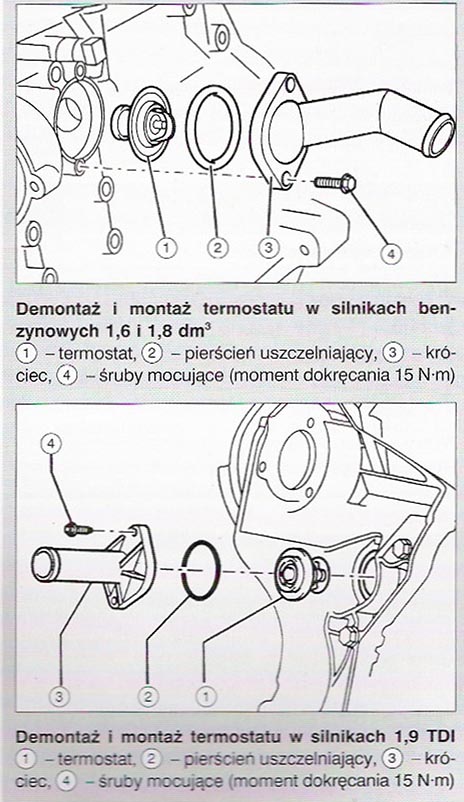Removing and checking the thermostat
Overheating of the engine while driving due to a damaged thermostat requires the car to be towed to a workshop or the thermostat removed. You have to wait with the repair until the engine cools down.
Depending on the type of engine, the thermostat is located in different places. It is usually mounted on the front of the engine block under the coolant hose mounting socket. In gasoline engines 1.4 l the thermostat is placed in a special housing at the end of the coolant pipe.
Before going to work, prepare the dish, to which you will drain the coolant, if the dismantled thermostat is found to be defective, it must be replaced with a new one. Thermostats cannot be repaired. By refitting a thermostat that is still operational, use a new gasket.
There is a way to check the suitability of the removed thermostat, however, this cannot be done on the go. Immerse the thermostat on the wire in a vessel with cold water. Heat the water and watch it, whether the thermostat starts to open at a temperature of approx. 86°C.
Thermostat opening temperatures
| Engine type | Beginning
opening (at ° C) |
Full
openly (at ° C) |
Jump
valve (mm) |
| Petrol | ok. 80-85 | ok. 102-105 | min 7 |
| Diesel | ok. 85 | ok. 105 | min 7 |
Check with a thermometer, that the thermostat valve extends the correct distance at the temperature specified in the table. For used thermostats, a tolerance of ± 3 ° C is allowed.
In the thermostat of a gasoline engine 1.4 l the valve stem should protrude at least by a distance 7 mm.
attention! A sticking thermostat can overheat and severely damage the engine. The boiling liquid reduces the cooling efficiency, if this happens to you while driving, stop immediately and tow the car to the repair shop.
Next steps:
1. Remove the noise canceling cover under the engine.
2. Remove the expansion tank cover to relieve system pressure. Drain the coolant from the system (see fluid change section).
attention. There is a risk of burns if the engine is hot. Drain the coolant from the system (see fluid change section).

3. Remove the thermostat as shown in the picture. Remove the flexible hose from the fitting. Unscrew the connecting bolts and remove it together with the thermostat (in engines 1,9 TDI turn the thermostat counterclockwise by 90 ° and remove it from the socket).
4. Proceed as follows to assemble: clean the contact surface of the rest of the gasket, coat the new ring with G12, attach the socket with the thermostat inside to the engine block (in engines 1,9 TDI insert the thermostat into the socket and turn o 1/4 clockwise rotation). When inserting the thermostat, set the valve handle to the horizontal position. Tighten the mounting bolts (tightening torque 15 Nm).
5. To test a new or used thermostat, hang it on a wire in a vessel with water and heat it up. The valve should open at the temperatures given in the table.
6. Pour the coolant back into the reservoir.
7. Attach the noise reduction cover.
Typical thermostat malfunction.
| Symptom of ailment | The reasons |
| A. The engine is too slow to reach operating temperature, insufficient heating of the car | The thermostat valve is stuck open (e.g. through the settlements), liquid flows through the radiator all the time and the engine takes too long to warm up. This will not damage the engine in a short time, but the thermostat must be replaced as soon as possible. |
| B. Coolant temperature control light is on despite correct coolant level. Radiator and lower radiator hose are cold | The thermostat valve is stuck closed (e.g. due to a damaged or leaking thermostat sleeve). Under no circumstances should you continue driving, because you will damage the engine due to overheating. |
